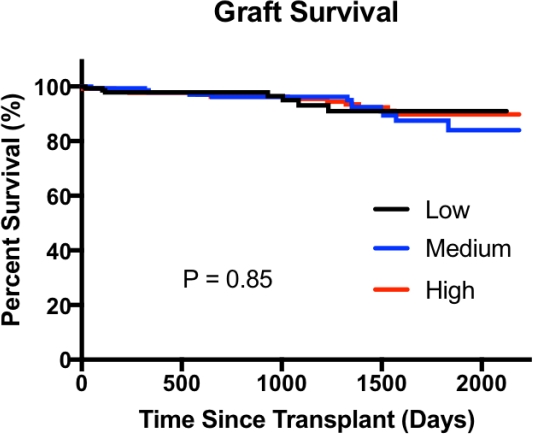Investigating the Variability of Fluid Resuscitation during Laparoscopic Donor Nephrectomy
1Department of Surgery, Section of Transplantation, University of Michigan, Ann Arbor, MI
2Department of Anesthesia, University of Michigan, Ann Arbor, MI.
Meeting: 2018 American Transplant Congress
Abstract number: B173
Keywords: Graft function, Graft survival, Kidney transplantation
Session Information
Session Name: Poster Session B: Kidney Living Donor: Long Term Outcomes
Session Type: Poster Session
Date: Sunday, June 3, 2018
Session Time: 6:00pm-7:00pm
 Presentation Time: 6:00pm-7:00pm
Presentation Time: 6:00pm-7:00pm
Location: Hall 4EF
Background: Under or over resuscitation during laparoscopic donor nephrectomy may have a significant effect on donor and graft outcomes. Despite the importance, no guidelines exist to optimize fluid management. We sought to quantify the variability in resuscitation at our institution and investigate the effects on donor and recipient outcomes.
Methods: A retrospective review of patients who underwent laparoscopic donor nephrectomy from 7/2011 to 12/2016 at a single center was performed. Patients were divided into tertiles of intraoperative fluid volume resuscitation rates (low-, medium-, and high-volume resuscitation). Donor and recipient demographics, intraoperative data, and recipient outcomes were analyzed. Analysis of variance (ANOVA) was used for comparisons among groups. Graft survival was analyzed using the Kaplan-Meier method with log-rank testing. A p value < 0.05 was considered statistically significant.
Results: Overall, 413 paired donors and kidney recipients were identified. Intraoperative fluid volume resuscitation was highly variable, with no correlation to donor weight (kg) (R=0.017). Following tertile division, intraoperative fluid volume resuscitation rates were significantly different (P < 0.001) among groups (cc/kg/hr: Low, 14.8 ± 2.9; Medium, 23.1 ± 2.2; High, 34.4 ± 7.3). No significant differences (P > 0.05) in patient demographics were noted among groups. Donor length of hospital stay was longer in high volume donors (days; High, 1.91 ± 0.8; Low, 1.72 ± 0.8), although not statistically significant (P = 0.13). There was no significant difference (P = 0.85) in graft survival among low-, medium-, and high- volume resuscitations donor groups. 
Conclusions: Volume of intraoperative fluid resuscitation does not appear to have a significant effect on graft survival following laparoscopic donor nephrectomy. An emphasis should be placed on optimizing intraoperative volume resuscitation, as additional resuscitation is likely not beneficial and may have negative implications.
CITATION INFORMATION: Williams A., Kumar S., Sung R., Woodside K., Englesbe M., Alameddine M., Waits S. Investigating the Variability of Fluid Resuscitation during Laparoscopic Donor Nephrectomy Am J Transplant. 2017;17 (suppl 3).
To cite this abstract in AMA style:
Williams A, Kumar S, Sung R, Woodside K, Englesbe M, Alameddine M, Waits S. Investigating the Variability of Fluid Resuscitation during Laparoscopic Donor Nephrectomy [abstract]. https://atcmeetingabstracts.com/abstract/investigating-the-variability-of-fluid-resuscitation-during-laparoscopic-donor-nephrectomy/. Accessed December 21, 2025.« Back to 2018 American Transplant Congress
